Business Environment Report: Business and its Environment Overview
VerifiedAdded on 2020/12/30
|12
|3676
|34
Report
AI Summary
This report provides a comprehensive overview of the business environment, examining different types of organizations such as private, public, and voluntary sectors, using examples like LEGO, Lloyds Bank, and Save the Children Fund. It explores their purposes, legal structures, sizes, and scopes. The report delves into the interrelationship between organizational functions, including marketing, sales, finance, and human resources, highlighting their impact on decision-making and objectives. It also analyzes macro environmental factors using PESTLE analysis and discusses the importance of SWOT analysis in gaining competitive advantages. The report concludes by emphasizing the interrelation of internal analysis with external macro factors, offering insights into how businesses can navigate and succeed within their environment.
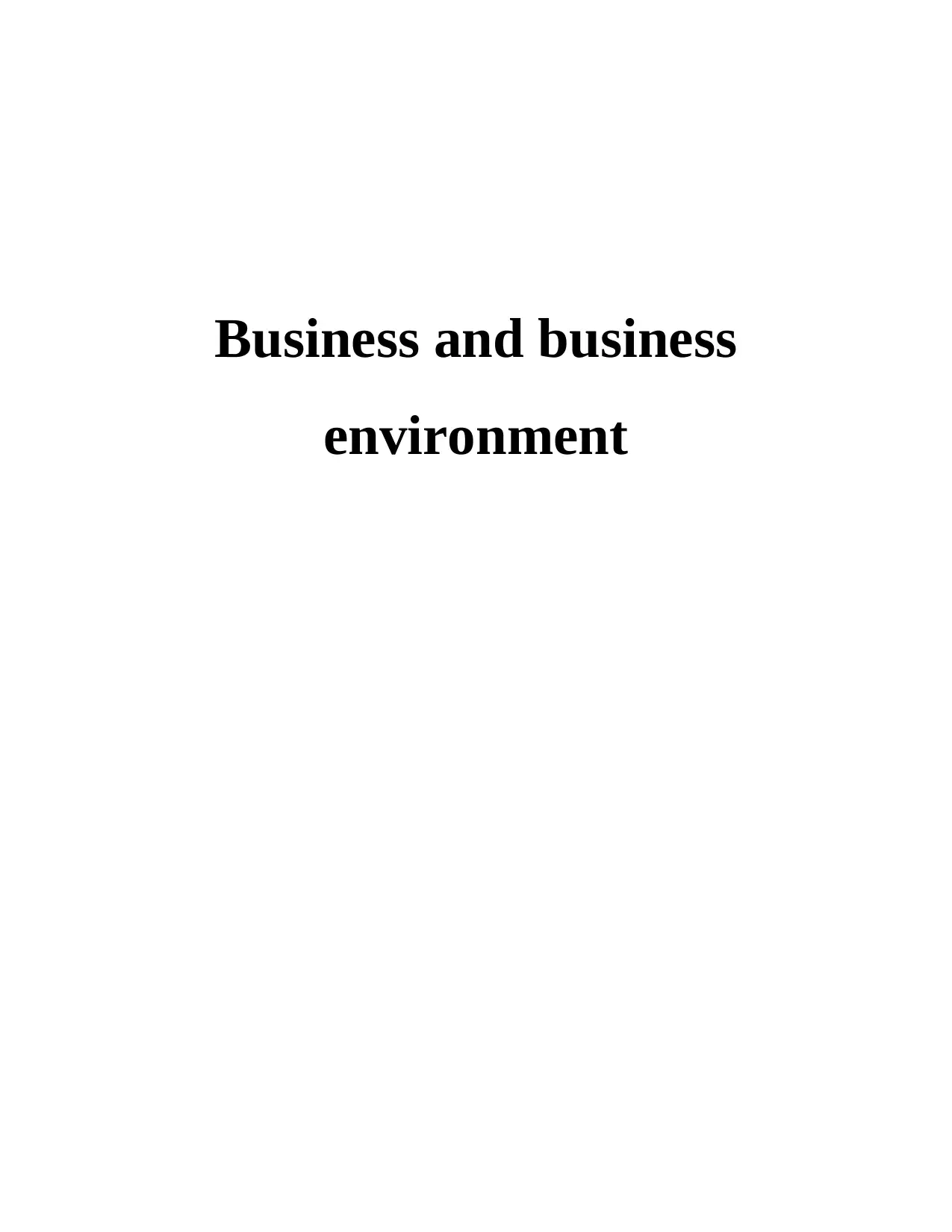
Business and business
environment
environment
Paraphrase This Document
Need a fresh take? Get an instant paraphrase of this document with our AI Paraphraser
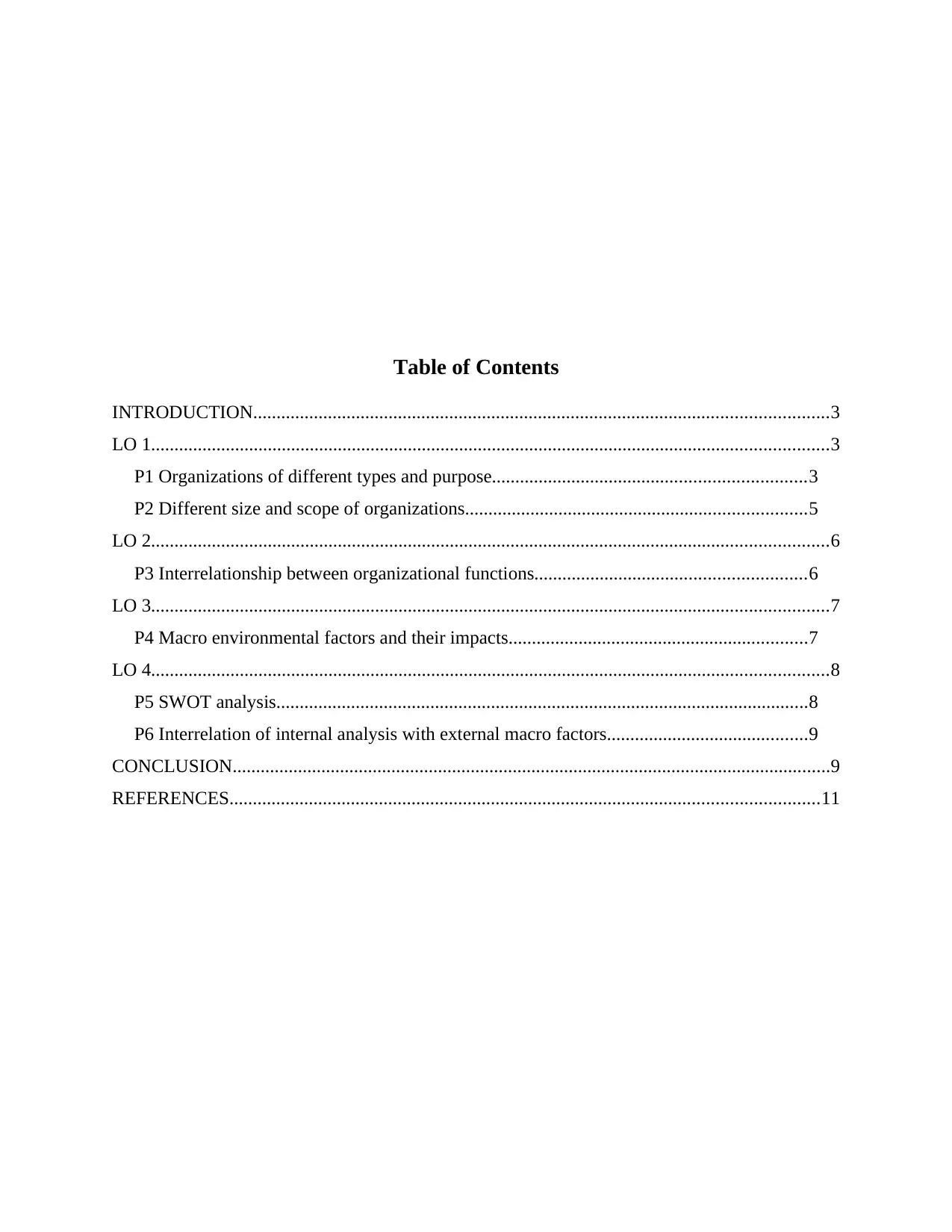
Table of Contents
INTRODUCTION...........................................................................................................................3
LO 1.................................................................................................................................................3
P1 Organizations of different types and purpose...................................................................3
P2 Different size and scope of organizations.........................................................................5
LO 2.................................................................................................................................................6
P3 Interrelationship between organizational functions..........................................................6
LO 3.................................................................................................................................................7
P4 Macro environmental factors and their impacts................................................................7
LO 4.................................................................................................................................................8
P5 SWOT analysis..................................................................................................................8
P6 Interrelation of internal analysis with external macro factors...........................................9
CONCLUSION................................................................................................................................9
REFERENCES..............................................................................................................................11
INTRODUCTION...........................................................................................................................3
LO 1.................................................................................................................................................3
P1 Organizations of different types and purpose...................................................................3
P2 Different size and scope of organizations.........................................................................5
LO 2.................................................................................................................................................6
P3 Interrelationship between organizational functions..........................................................6
LO 3.................................................................................................................................................7
P4 Macro environmental factors and their impacts................................................................7
LO 4.................................................................................................................................................8
P5 SWOT analysis..................................................................................................................8
P6 Interrelation of internal analysis with external macro factors...........................................9
CONCLUSION................................................................................................................................9
REFERENCES..............................................................................................................................11
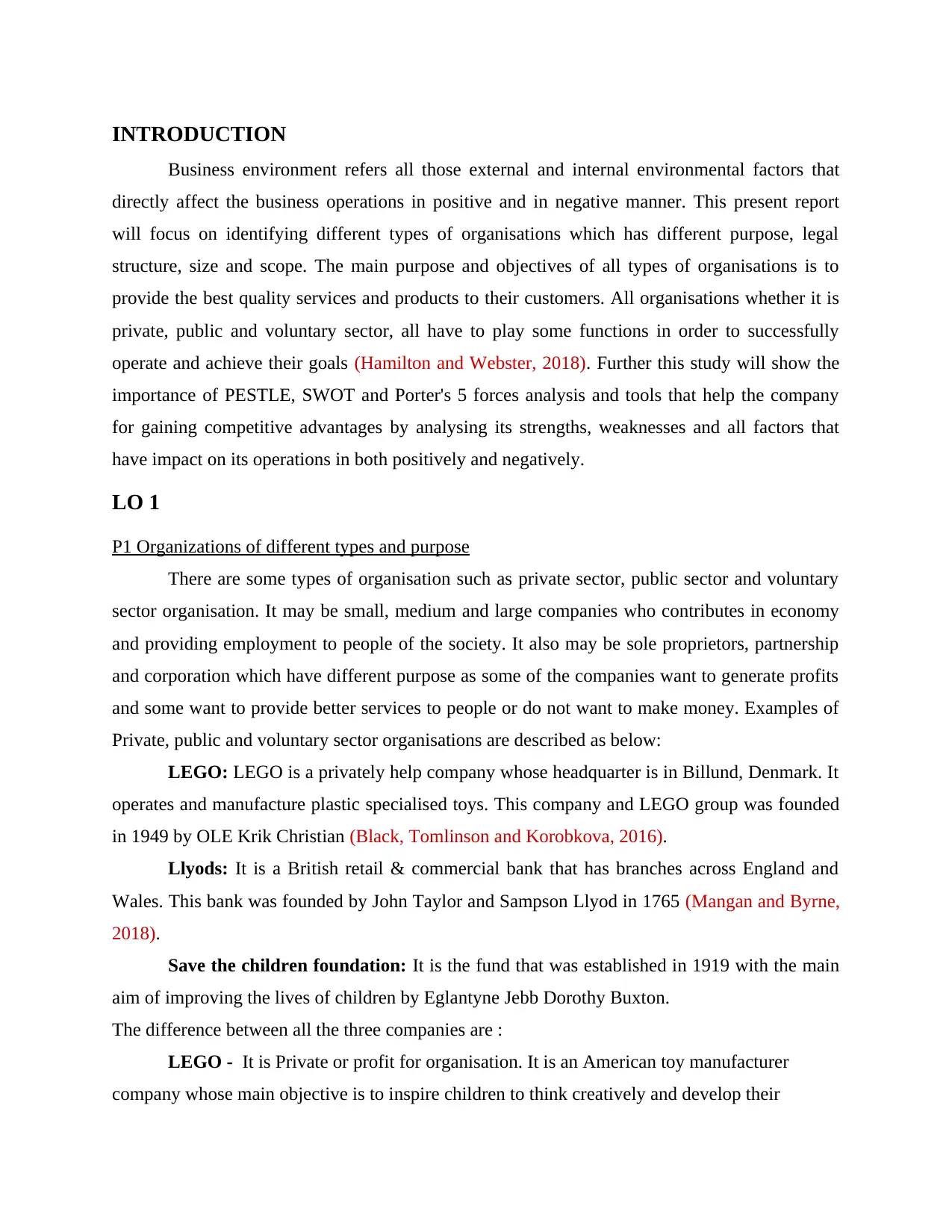
INTRODUCTION
Business environment refers all those external and internal environmental factors that
directly affect the business operations in positive and in negative manner. This present report
will focus on identifying different types of organisations which has different purpose, legal
structure, size and scope. The main purpose and objectives of all types of organisations is to
provide the best quality services and products to their customers. All organisations whether it is
private, public and voluntary sector, all have to play some functions in order to successfully
operate and achieve their goals (Hamilton and Webster, 2018). Further this study will show the
importance of PESTLE, SWOT and Porter's 5 forces analysis and tools that help the company
for gaining competitive advantages by analysing its strengths, weaknesses and all factors that
have impact on its operations in both positively and negatively.
LO 1
P1 Organizations of different types and purpose
There are some types of organisation such as private sector, public sector and voluntary
sector organisation. It may be small, medium and large companies who contributes in economy
and providing employment to people of the society. It also may be sole proprietors, partnership
and corporation which have different purpose as some of the companies want to generate profits
and some want to provide better services to people or do not want to make money. Examples of
Private, public and voluntary sector organisations are described as below:
LEGO: LEGO is a privately help company whose headquarter is in Billund, Denmark. It
operates and manufacture plastic specialised toys. This company and LEGO group was founded
in 1949 by OLE Krik Christian (Black, Tomlinson and Korobkova, 2016).
Llyods: It is a British retail & commercial bank that has branches across England and
Wales. This bank was founded by John Taylor and Sampson Llyod in 1765 (Mangan and Byrne,
2018).
Save the children foundation: It is the fund that was established in 1919 with the main
aim of improving the lives of children by Eglantyne Jebb Dorothy Buxton.
The difference between all the three companies are :
LEGO - It is Private or profit for organisation. It is an American toy manufacturer
company whose main objective is to inspire children to think creatively and develop their
Business environment refers all those external and internal environmental factors that
directly affect the business operations in positive and in negative manner. This present report
will focus on identifying different types of organisations which has different purpose, legal
structure, size and scope. The main purpose and objectives of all types of organisations is to
provide the best quality services and products to their customers. All organisations whether it is
private, public and voluntary sector, all have to play some functions in order to successfully
operate and achieve their goals (Hamilton and Webster, 2018). Further this study will show the
importance of PESTLE, SWOT and Porter's 5 forces analysis and tools that help the company
for gaining competitive advantages by analysing its strengths, weaknesses and all factors that
have impact on its operations in both positively and negatively.
LO 1
P1 Organizations of different types and purpose
There are some types of organisation such as private sector, public sector and voluntary
sector organisation. It may be small, medium and large companies who contributes in economy
and providing employment to people of the society. It also may be sole proprietors, partnership
and corporation which have different purpose as some of the companies want to generate profits
and some want to provide better services to people or do not want to make money. Examples of
Private, public and voluntary sector organisations are described as below:
LEGO: LEGO is a privately help company whose headquarter is in Billund, Denmark. It
operates and manufacture plastic specialised toys. This company and LEGO group was founded
in 1949 by OLE Krik Christian (Black, Tomlinson and Korobkova, 2016).
Llyods: It is a British retail & commercial bank that has branches across England and
Wales. This bank was founded by John Taylor and Sampson Llyod in 1765 (Mangan and Byrne,
2018).
Save the children foundation: It is the fund that was established in 1919 with the main
aim of improving the lives of children by Eglantyne Jebb Dorothy Buxton.
The difference between all the three companies are :
LEGO - It is Private or profit for organisation. It is an American toy manufacturer
company whose main objective is to inspire children to think creatively and develop their
⊘ This is a preview!⊘
Do you want full access?
Subscribe today to unlock all pages.

Trusted by 1+ million students worldwide
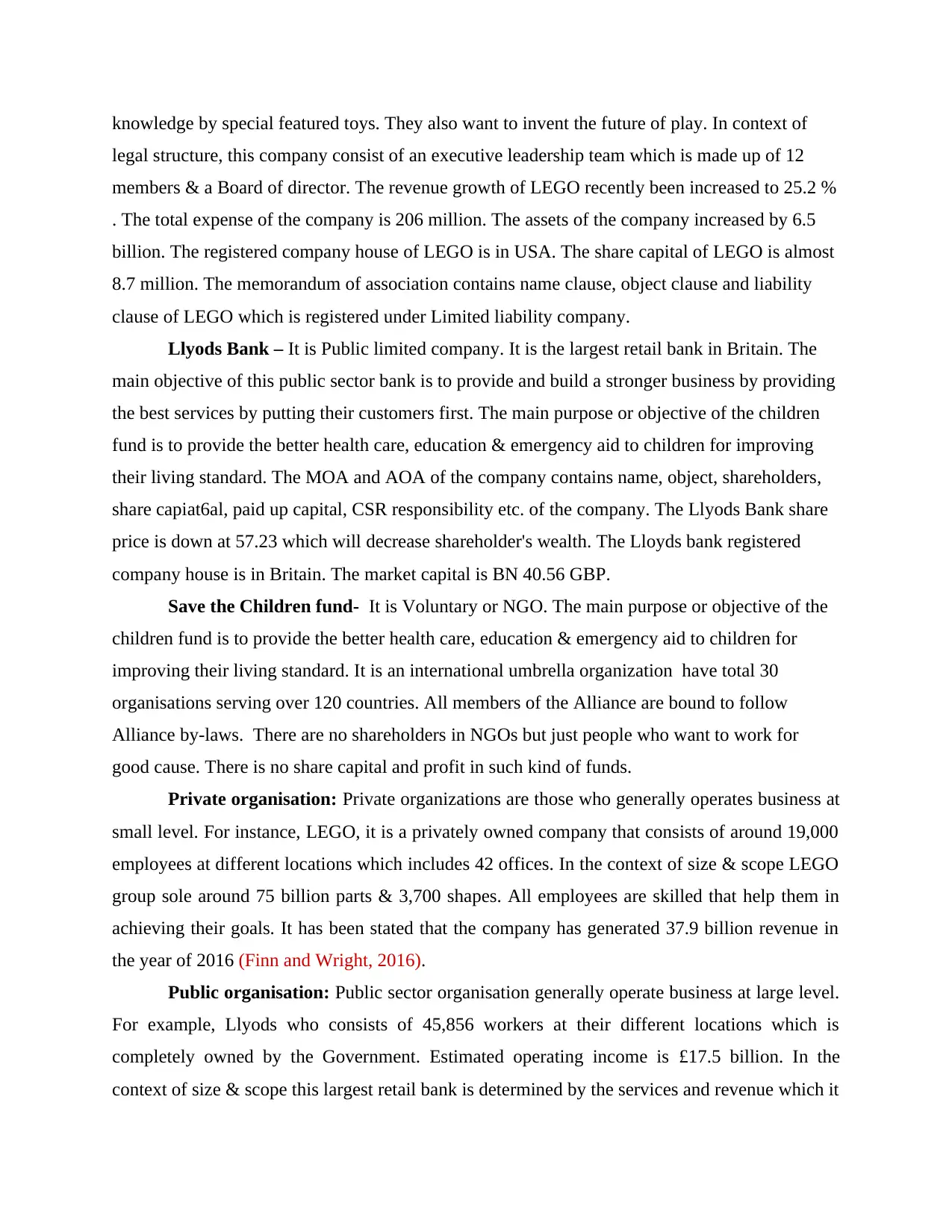
knowledge by special featured toys. They also want to invent the future of play. In context of
legal structure, this company consist of an executive leadership team which is made up of 12
members & a Board of director. The revenue growth of LEGO recently been increased to 25.2 %
. The total expense of the company is 206 million. The assets of the company increased by 6.5
billion. The registered company house of LEGO is in USA. The share capital of LEGO is almost
8.7 million. The memorandum of association contains name clause, object clause and liability
clause of LEGO which is registered under Limited liability company.
Llyods Bank – It is Public limited company. It is the largest retail bank in Britain. The
main objective of this public sector bank is to provide and build a stronger business by providing
the best services by putting their customers first. The main purpose or objective of the children
fund is to provide the better health care, education & emergency aid to children for improving
their living standard. The MOA and AOA of the company contains name, object, shareholders,
share capiat6al, paid up capital, CSR responsibility etc. of the company. The Llyods Bank share
price is down at 57.23 which will decrease shareholder's wealth. The Lloyds bank registered
company house is in Britain. The market capital is BN 40.56 GBP.
Save the Children fund- It is Voluntary or NGO. The main purpose or objective of the
children fund is to provide the better health care, education & emergency aid to children for
improving their living standard. It is an international umbrella organization have total 30
organisations serving over 120 countries. All members of the Alliance are bound to follow
Alliance by-laws. There are no shareholders in NGOs but just people who want to work for
good cause. There is no share capital and profit in such kind of funds.
Private organisation: Private organizations are those who generally operates business at
small level. For instance, LEGO, it is a privately owned company that consists of around 19,000
employees at different locations which includes 42 offices. In the context of size & scope LEGO
group sole around 75 billion parts & 3,700 shapes. All employees are skilled that help them in
achieving their goals. It has been stated that the company has generated 37.9 billion revenue in
the year of 2016 (Finn and Wright, 2016).
Public organisation: Public sector organisation generally operate business at large level.
For example, Llyods who consists of 45,856 workers at their different locations which is
completely owned by the Government. Estimated operating income is £17.5 billion. In the
context of size & scope this largest retail bank is determined by the services and revenue which it
legal structure, this company consist of an executive leadership team which is made up of 12
members & a Board of director. The revenue growth of LEGO recently been increased to 25.2 %
. The total expense of the company is 206 million. The assets of the company increased by 6.5
billion. The registered company house of LEGO is in USA. The share capital of LEGO is almost
8.7 million. The memorandum of association contains name clause, object clause and liability
clause of LEGO which is registered under Limited liability company.
Llyods Bank – It is Public limited company. It is the largest retail bank in Britain. The
main objective of this public sector bank is to provide and build a stronger business by providing
the best services by putting their customers first. The main purpose or objective of the children
fund is to provide the better health care, education & emergency aid to children for improving
their living standard. The MOA and AOA of the company contains name, object, shareholders,
share capiat6al, paid up capital, CSR responsibility etc. of the company. The Llyods Bank share
price is down at 57.23 which will decrease shareholder's wealth. The Lloyds bank registered
company house is in Britain. The market capital is BN 40.56 GBP.
Save the Children fund- It is Voluntary or NGO. The main purpose or objective of the
children fund is to provide the better health care, education & emergency aid to children for
improving their living standard. It is an international umbrella organization have total 30
organisations serving over 120 countries. All members of the Alliance are bound to follow
Alliance by-laws. There are no shareholders in NGOs but just people who want to work for
good cause. There is no share capital and profit in such kind of funds.
Private organisation: Private organizations are those who generally operates business at
small level. For instance, LEGO, it is a privately owned company that consists of around 19,000
employees at different locations which includes 42 offices. In the context of size & scope LEGO
group sole around 75 billion parts & 3,700 shapes. All employees are skilled that help them in
achieving their goals. It has been stated that the company has generated 37.9 billion revenue in
the year of 2016 (Finn and Wright, 2016).
Public organisation: Public sector organisation generally operate business at large level.
For example, Llyods who consists of 45,856 workers at their different locations which is
completely owned by the Government. Estimated operating income is £17.5 billion. In the
context of size & scope this largest retail bank is determined by the services and revenue which it
Paraphrase This Document
Need a fresh take? Get an instant paraphrase of this document with our AI Paraphraser
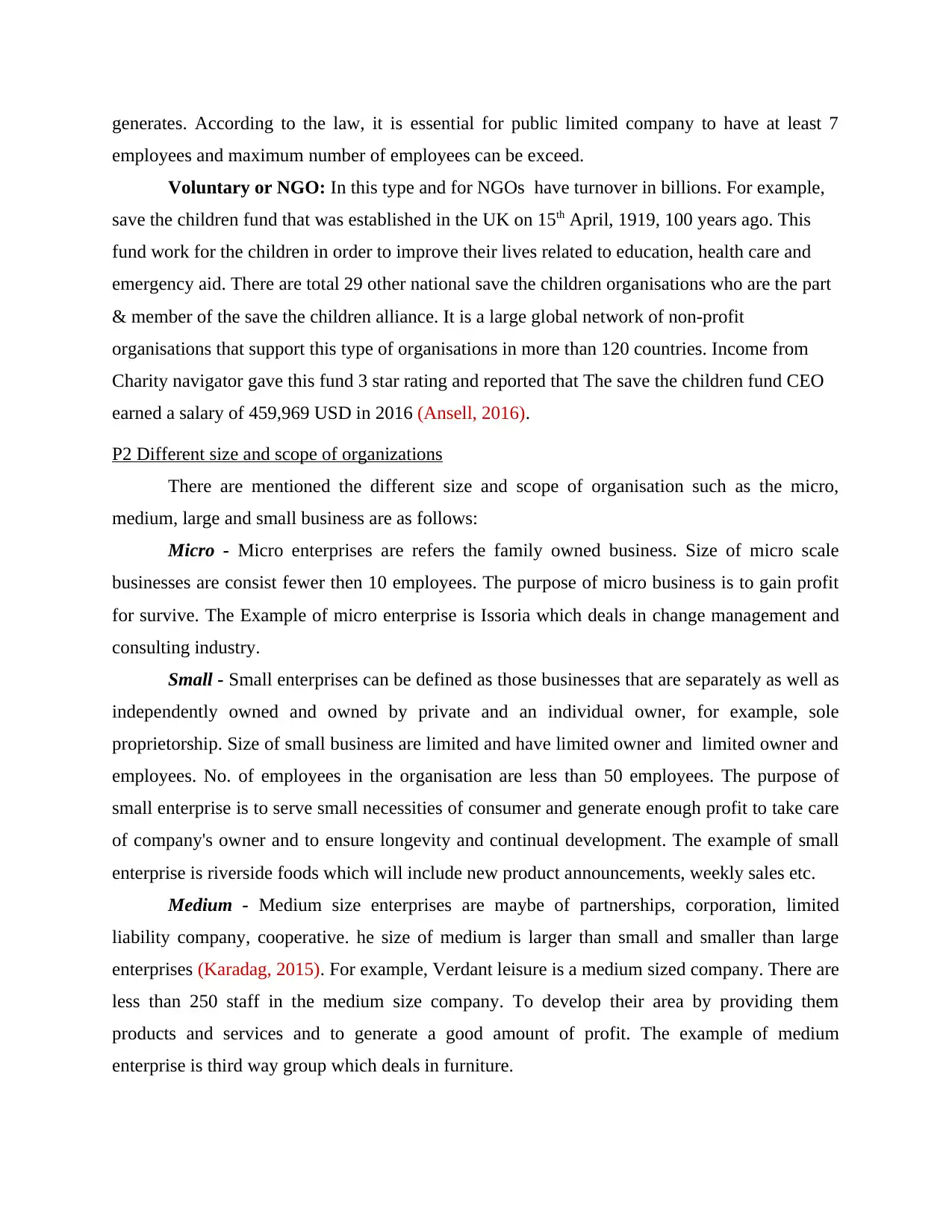
generates. According to the law, it is essential for public limited company to have at least 7
employees and maximum number of employees can be exceed.
Voluntary or NGO: In this type and for NGOs have turnover in billions. For example,
save the children fund that was established in the UK on 15th April, 1919, 100 years ago. This
fund work for the children in order to improve their lives related to education, health care and
emergency aid. There are total 29 other national save the children organisations who are the part
& member of the save the children alliance. It is a large global network of non-profit
organisations that support this type of organisations in more than 120 countries. Income from
Charity navigator gave this fund 3 star rating and reported that The save the children fund CEO
earned a salary of 459,969 USD in 2016 (Ansell, 2016).
P2 Different size and scope of organizations
There are mentioned the different size and scope of organisation such as the micro,
medium, large and small business are as follows:
Micro - Micro enterprises are refers the family owned business. Size of micro scale
businesses are consist fewer then 10 employees. The purpose of micro business is to gain profit
for survive. The Example of micro enterprise is Issoria which deals in change management and
consulting industry.
Small - Small enterprises can be defined as those businesses that are separately as well as
independently owned and owned by private and an individual owner, for example, sole
proprietorship. Size of small business are limited and have limited owner and limited owner and
employees. No. of employees in the organisation are less than 50 employees. The purpose of
small enterprise is to serve small necessities of consumer and generate enough profit to take care
of company's owner and to ensure longevity and continual development. The example of small
enterprise is riverside foods which will include new product announcements, weekly sales etc.
Medium - Medium size enterprises are maybe of partnerships, corporation, limited
liability company, cooperative. he size of medium is larger than small and smaller than large
enterprises (Karadag, 2015). For example, Verdant leisure is a medium sized company. There are
less than 250 staff in the medium size company. To develop their area by providing them
products and services and to generate a good amount of profit. The example of medium
enterprise is third way group which deals in furniture.
employees and maximum number of employees can be exceed.
Voluntary or NGO: In this type and for NGOs have turnover in billions. For example,
save the children fund that was established in the UK on 15th April, 1919, 100 years ago. This
fund work for the children in order to improve their lives related to education, health care and
emergency aid. There are total 29 other national save the children organisations who are the part
& member of the save the children alliance. It is a large global network of non-profit
organisations that support this type of organisations in more than 120 countries. Income from
Charity navigator gave this fund 3 star rating and reported that The save the children fund CEO
earned a salary of 459,969 USD in 2016 (Ansell, 2016).
P2 Different size and scope of organizations
There are mentioned the different size and scope of organisation such as the micro,
medium, large and small business are as follows:
Micro - Micro enterprises are refers the family owned business. Size of micro scale
businesses are consist fewer then 10 employees. The purpose of micro business is to gain profit
for survive. The Example of micro enterprise is Issoria which deals in change management and
consulting industry.
Small - Small enterprises can be defined as those businesses that are separately as well as
independently owned and owned by private and an individual owner, for example, sole
proprietorship. Size of small business are limited and have limited owner and limited owner and
employees. No. of employees in the organisation are less than 50 employees. The purpose of
small enterprise is to serve small necessities of consumer and generate enough profit to take care
of company's owner and to ensure longevity and continual development. The example of small
enterprise is riverside foods which will include new product announcements, weekly sales etc.
Medium - Medium size enterprises are maybe of partnerships, corporation, limited
liability company, cooperative. he size of medium is larger than small and smaller than large
enterprises (Karadag, 2015). For example, Verdant leisure is a medium sized company. There are
less than 250 staff in the medium size company. To develop their area by providing them
products and services and to generate a good amount of profit. The example of medium
enterprise is third way group which deals in furniture.
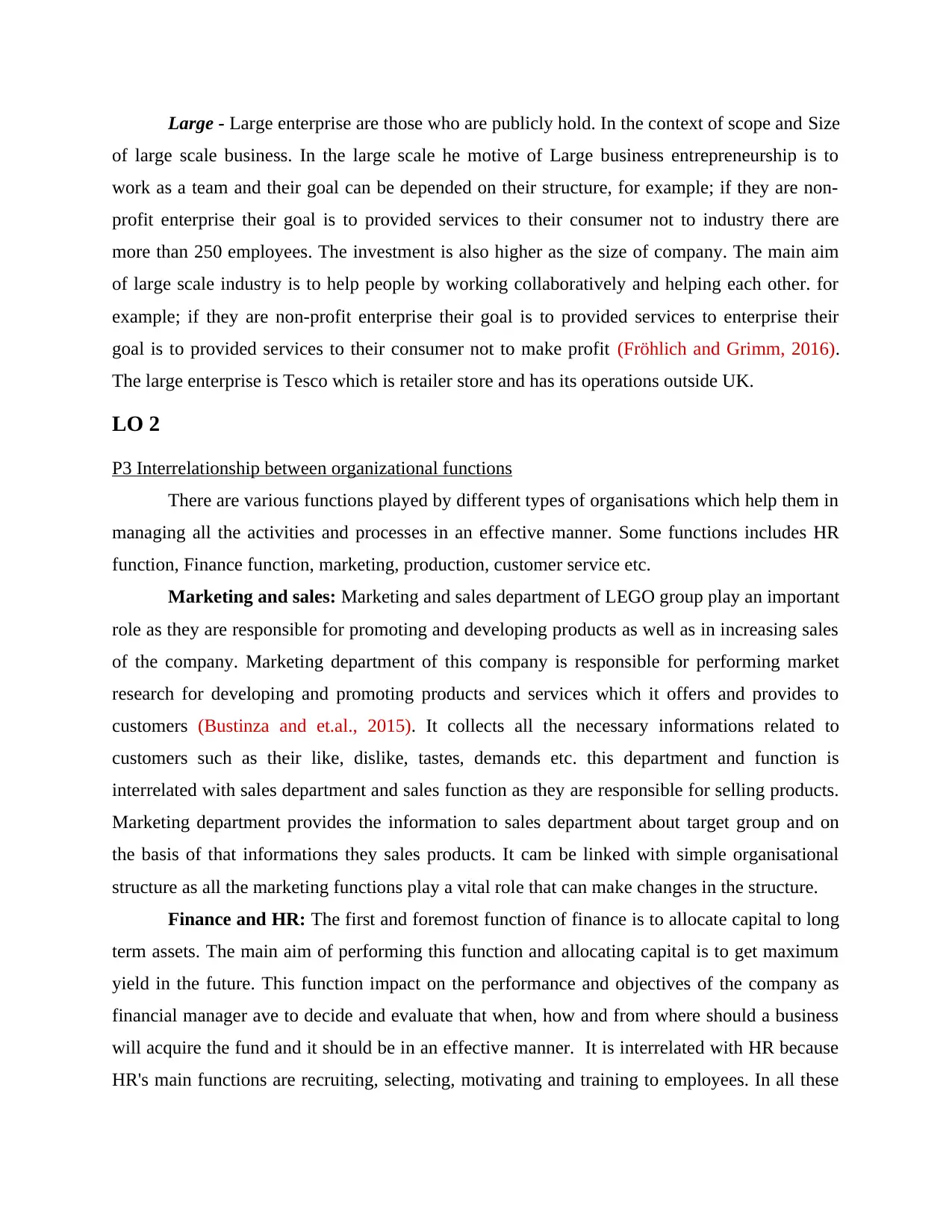
Large - Large enterprise are those who are publicly hold. In the context of scope and Size
of large scale business. In the large scale he motive of Large business entrepreneurship is to
work as a team and their goal can be depended on their structure, for example; if they are non-
profit enterprise their goal is to provided services to their consumer not to industry there are
more than 250 employees. The investment is also higher as the size of company. The main aim
of large scale industry is to help people by working collaboratively and helping each other. for
example; if they are non-profit enterprise their goal is to provided services to enterprise their
goal is to provided services to their consumer not to make profit (Fröhlich and Grimm, 2016).
The large enterprise is Tesco which is retailer store and has its operations outside UK.
LO 2
P3 Interrelationship between organizational functions
There are various functions played by different types of organisations which help them in
managing all the activities and processes in an effective manner. Some functions includes HR
function, Finance function, marketing, production, customer service etc.
Marketing and sales: Marketing and sales department of LEGO group play an important
role as they are responsible for promoting and developing products as well as in increasing sales
of the company. Marketing department of this company is responsible for performing market
research for developing and promoting products and services which it offers and provides to
customers (Bustinza and et.al., 2015). It collects all the necessary informations related to
customers such as their like, dislike, tastes, demands etc. this department and function is
interrelated with sales department and sales function as they are responsible for selling products.
Marketing department provides the information to sales department about target group and on
the basis of that informations they sales products. It cam be linked with simple organisational
structure as all the marketing functions play a vital role that can make changes in the structure.
Finance and HR: The first and foremost function of finance is to allocate capital to long
term assets. The main aim of performing this function and allocating capital is to get maximum
yield in the future. This function impact on the performance and objectives of the company as
financial manager ave to decide and evaluate that when, how and from where should a business
will acquire the fund and it should be in an effective manner. It is interrelated with HR because
HR's main functions are recruiting, selecting, motivating and training to employees. In all these
of large scale business. In the large scale he motive of Large business entrepreneurship is to
work as a team and their goal can be depended on their structure, for example; if they are non-
profit enterprise their goal is to provided services to their consumer not to industry there are
more than 250 employees. The investment is also higher as the size of company. The main aim
of large scale industry is to help people by working collaboratively and helping each other. for
example; if they are non-profit enterprise their goal is to provided services to enterprise their
goal is to provided services to their consumer not to make profit (Fröhlich and Grimm, 2016).
The large enterprise is Tesco which is retailer store and has its operations outside UK.
LO 2
P3 Interrelationship between organizational functions
There are various functions played by different types of organisations which help them in
managing all the activities and processes in an effective manner. Some functions includes HR
function, Finance function, marketing, production, customer service etc.
Marketing and sales: Marketing and sales department of LEGO group play an important
role as they are responsible for promoting and developing products as well as in increasing sales
of the company. Marketing department of this company is responsible for performing market
research for developing and promoting products and services which it offers and provides to
customers (Bustinza and et.al., 2015). It collects all the necessary informations related to
customers such as their like, dislike, tastes, demands etc. this department and function is
interrelated with sales department and sales function as they are responsible for selling products.
Marketing department provides the information to sales department about target group and on
the basis of that informations they sales products. It cam be linked with simple organisational
structure as all the marketing functions play a vital role that can make changes in the structure.
Finance and HR: The first and foremost function of finance is to allocate capital to long
term assets. The main aim of performing this function and allocating capital is to get maximum
yield in the future. This function impact on the performance and objectives of the company as
financial manager ave to decide and evaluate that when, how and from where should a business
will acquire the fund and it should be in an effective manner. It is interrelated with HR because
HR's main functions are recruiting, selecting, motivating and training to employees. In all these
⊘ This is a preview!⊘
Do you want full access?
Subscribe today to unlock all pages.

Trusted by 1+ million students worldwide
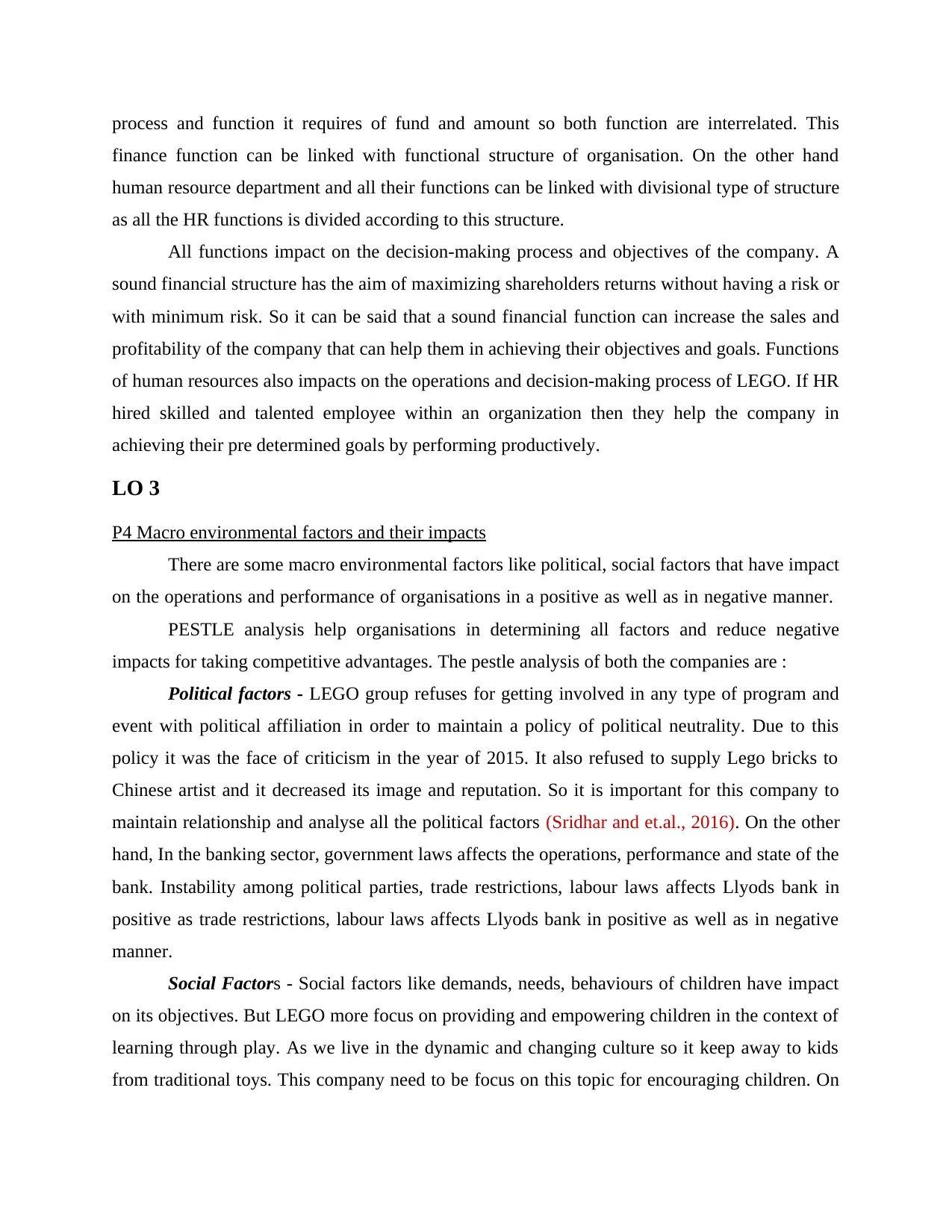
process and function it requires of fund and amount so both function are interrelated. This
finance function can be linked with functional structure of organisation. On the other hand
human resource department and all their functions can be linked with divisional type of structure
as all the HR functions is divided according to this structure.
All functions impact on the decision-making process and objectives of the company. A
sound financial structure has the aim of maximizing shareholders returns without having a risk or
with minimum risk. So it can be said that a sound financial function can increase the sales and
profitability of the company that can help them in achieving their objectives and goals. Functions
of human resources also impacts on the operations and decision-making process of LEGO. If HR
hired skilled and talented employee within an organization then they help the company in
achieving their pre determined goals by performing productively.
LO 3
P4 Macro environmental factors and their impacts
There are some macro environmental factors like political, social factors that have impact
on the operations and performance of organisations in a positive as well as in negative manner.
PESTLE analysis help organisations in determining all factors and reduce negative
impacts for taking competitive advantages. The pestle analysis of both the companies are :
Political factors - LEGO group refuses for getting involved in any type of program and
event with political affiliation in order to maintain a policy of political neutrality. Due to this
policy it was the face of criticism in the year of 2015. It also refused to supply Lego bricks to
Chinese artist and it decreased its image and reputation. So it is important for this company to
maintain relationship and analyse all the political factors (Sridhar and et.al., 2016). On the other
hand, In the banking sector, government laws affects the operations, performance and state of the
bank. Instability among political parties, trade restrictions, labour laws affects Llyods bank in
positive as trade restrictions, labour laws affects Llyods bank in positive as well as in negative
manner.
Social Factors - Social factors like demands, needs, behaviours of children have impact
on its objectives. But LEGO more focus on providing and empowering children in the context of
learning through play. As we live in the dynamic and changing culture so it keep away to kids
from traditional toys. This company need to be focus on this topic for encouraging children. On
finance function can be linked with functional structure of organisation. On the other hand
human resource department and all their functions can be linked with divisional type of structure
as all the HR functions is divided according to this structure.
All functions impact on the decision-making process and objectives of the company. A
sound financial structure has the aim of maximizing shareholders returns without having a risk or
with minimum risk. So it can be said that a sound financial function can increase the sales and
profitability of the company that can help them in achieving their objectives and goals. Functions
of human resources also impacts on the operations and decision-making process of LEGO. If HR
hired skilled and talented employee within an organization then they help the company in
achieving their pre determined goals by performing productively.
LO 3
P4 Macro environmental factors and their impacts
There are some macro environmental factors like political, social factors that have impact
on the operations and performance of organisations in a positive as well as in negative manner.
PESTLE analysis help organisations in determining all factors and reduce negative
impacts for taking competitive advantages. The pestle analysis of both the companies are :
Political factors - LEGO group refuses for getting involved in any type of program and
event with political affiliation in order to maintain a policy of political neutrality. Due to this
policy it was the face of criticism in the year of 2015. It also refused to supply Lego bricks to
Chinese artist and it decreased its image and reputation. So it is important for this company to
maintain relationship and analyse all the political factors (Sridhar and et.al., 2016). On the other
hand, In the banking sector, government laws affects the operations, performance and state of the
bank. Instability among political parties, trade restrictions, labour laws affects Llyods bank in
positive as trade restrictions, labour laws affects Llyods bank in positive as well as in negative
manner.
Social Factors - Social factors like demands, needs, behaviours of children have impact
on its objectives. But LEGO more focus on providing and empowering children in the context of
learning through play. As we live in the dynamic and changing culture so it keep away to kids
from traditional toys. This company need to be focus on this topic for encouraging children. On
Paraphrase This Document
Need a fresh take? Get an instant paraphrase of this document with our AI Paraphraser
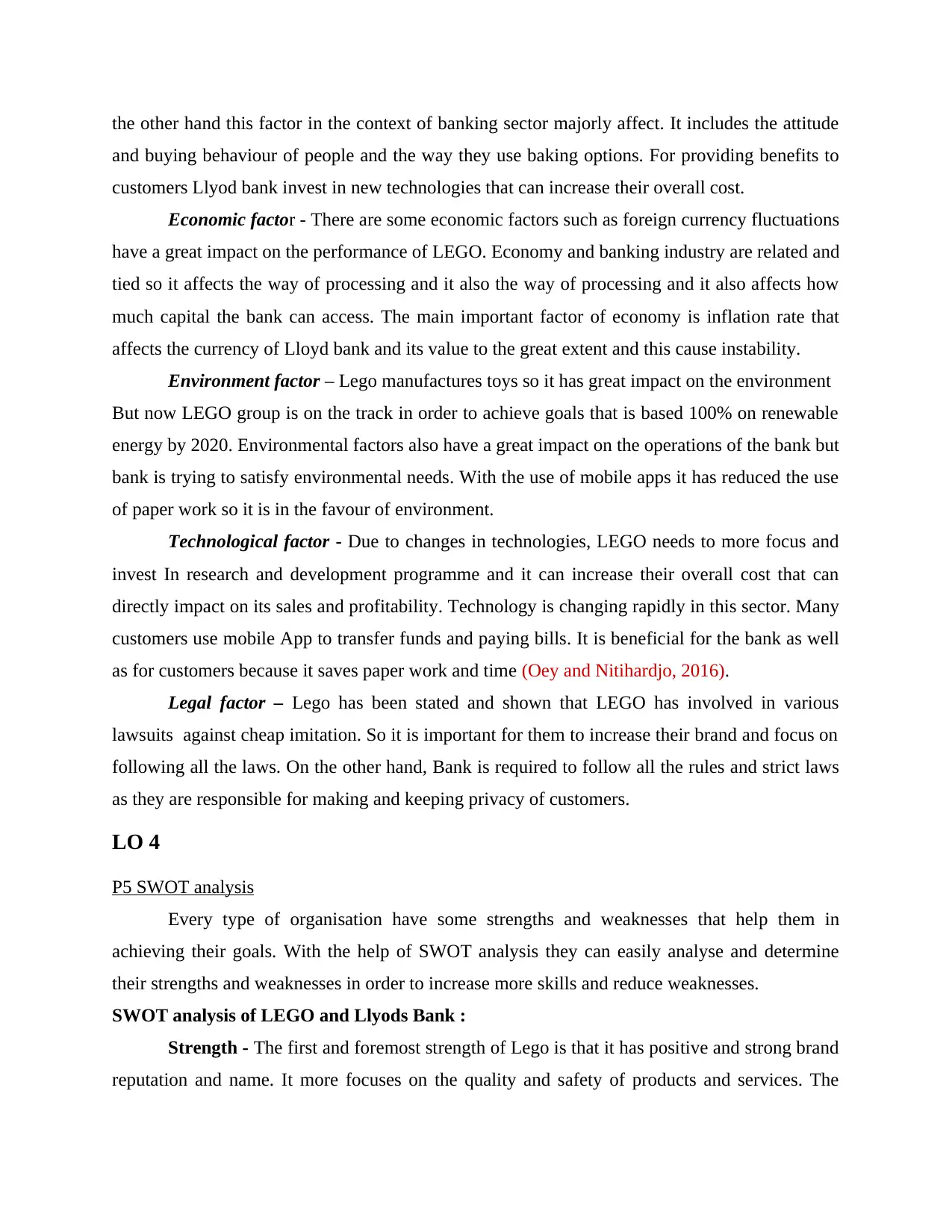
the other hand this factor in the context of banking sector majorly affect. It includes the attitude
and buying behaviour of people and the way they use baking options. For providing benefits to
customers Llyod bank invest in new technologies that can increase their overall cost.
Economic factor - There are some economic factors such as foreign currency fluctuations
have a great impact on the performance of LEGO. Economy and banking industry are related and
tied so it affects the way of processing and it also the way of processing and it also affects how
much capital the bank can access. The main important factor of economy is inflation rate that
affects the currency of Lloyd bank and its value to the great extent and this cause instability.
Environment factor – Lego manufactures toys so it has great impact on the environment
But now LEGO group is on the track in order to achieve goals that is based 100% on renewable
energy by 2020. Environmental factors also have a great impact on the operations of the bank but
bank is trying to satisfy environmental needs. With the use of mobile apps it has reduced the use
of paper work so it is in the favour of environment.
Technological factor - Due to changes in technologies, LEGO needs to more focus and
invest In research and development programme and it can increase their overall cost that can
directly impact on its sales and profitability. Technology is changing rapidly in this sector. Many
customers use mobile App to transfer funds and paying bills. It is beneficial for the bank as well
as for customers because it saves paper work and time (Oey and Nitihardjo, 2016).
Legal factor – Lego has been stated and shown that LEGO has involved in various
lawsuits against cheap imitation. So it is important for them to increase their brand and focus on
following all the laws. On the other hand, Bank is required to follow all the rules and strict laws
as they are responsible for making and keeping privacy of customers.
LO 4
P5 SWOT analysis
Every type of organisation have some strengths and weaknesses that help them in
achieving their goals. With the help of SWOT analysis they can easily analyse and determine
their strengths and weaknesses in order to increase more skills and reduce weaknesses.
SWOT analysis of LEGO and Llyods Bank :
Strength - The first and foremost strength of Lego is that it has positive and strong brand
reputation and name. It more focuses on the quality and safety of products and services. The
and buying behaviour of people and the way they use baking options. For providing benefits to
customers Llyod bank invest in new technologies that can increase their overall cost.
Economic factor - There are some economic factors such as foreign currency fluctuations
have a great impact on the performance of LEGO. Economy and banking industry are related and
tied so it affects the way of processing and it also the way of processing and it also affects how
much capital the bank can access. The main important factor of economy is inflation rate that
affects the currency of Lloyd bank and its value to the great extent and this cause instability.
Environment factor – Lego manufactures toys so it has great impact on the environment
But now LEGO group is on the track in order to achieve goals that is based 100% on renewable
energy by 2020. Environmental factors also have a great impact on the operations of the bank but
bank is trying to satisfy environmental needs. With the use of mobile apps it has reduced the use
of paper work so it is in the favour of environment.
Technological factor - Due to changes in technologies, LEGO needs to more focus and
invest In research and development programme and it can increase their overall cost that can
directly impact on its sales and profitability. Technology is changing rapidly in this sector. Many
customers use mobile App to transfer funds and paying bills. It is beneficial for the bank as well
as for customers because it saves paper work and time (Oey and Nitihardjo, 2016).
Legal factor – Lego has been stated and shown that LEGO has involved in various
lawsuits against cheap imitation. So it is important for them to increase their brand and focus on
following all the laws. On the other hand, Bank is required to follow all the rules and strict laws
as they are responsible for making and keeping privacy of customers.
LO 4
P5 SWOT analysis
Every type of organisation have some strengths and weaknesses that help them in
achieving their goals. With the help of SWOT analysis they can easily analyse and determine
their strengths and weaknesses in order to increase more skills and reduce weaknesses.
SWOT analysis of LEGO and Llyods Bank :
Strength - The first and foremost strength of Lego is that it has positive and strong brand
reputation and name. It more focuses on the quality and safety of products and services. The
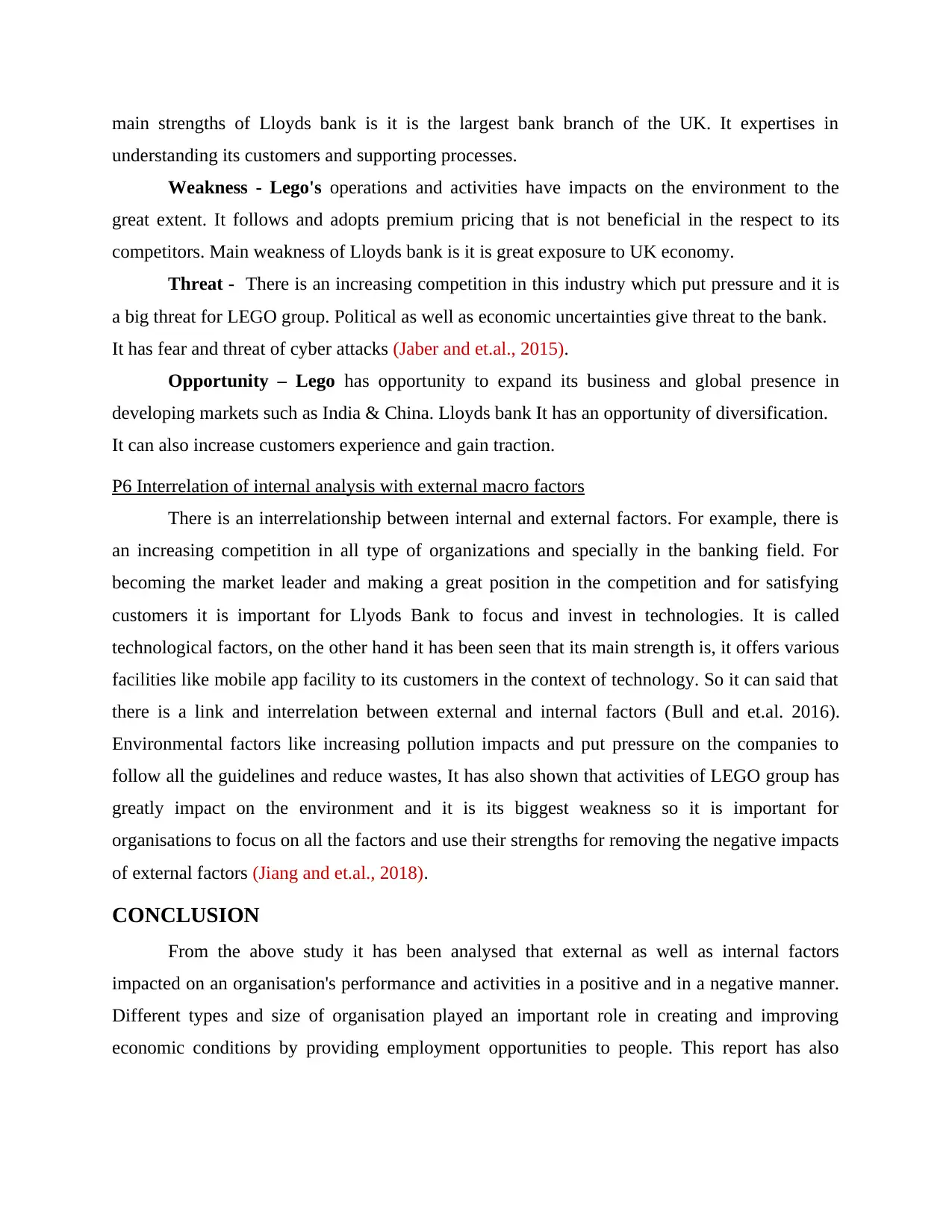
main strengths of Lloyds bank is it is the largest bank branch of the UK. It expertises in
understanding its customers and supporting processes.
Weakness - Lego's operations and activities have impacts on the environment to the
great extent. It follows and adopts premium pricing that is not beneficial in the respect to its
competitors. Main weakness of Lloyds bank is it is great exposure to UK economy.
Threat - There is an increasing competition in this industry which put pressure and it is
a big threat for LEGO group. Political as well as economic uncertainties give threat to the bank.
It has fear and threat of cyber attacks (Jaber and et.al., 2015).
Opportunity – Lego has opportunity to expand its business and global presence in
developing markets such as India & China. Lloyds bank It has an opportunity of diversification.
It can also increase customers experience and gain traction.
P6 Interrelation of internal analysis with external macro factors
There is an interrelationship between internal and external factors. For example, there is
an increasing competition in all type of organizations and specially in the banking field. For
becoming the market leader and making a great position in the competition and for satisfying
customers it is important for Llyods Bank to focus and invest in technologies. It is called
technological factors, on the other hand it has been seen that its main strength is, it offers various
facilities like mobile app facility to its customers in the context of technology. So it can said that
there is a link and interrelation between external and internal factors (Bull and et.al. 2016).
Environmental factors like increasing pollution impacts and put pressure on the companies to
follow all the guidelines and reduce wastes, It has also shown that activities of LEGO group has
greatly impact on the environment and it is its biggest weakness so it is important for
organisations to focus on all the factors and use their strengths for removing the negative impacts
of external factors (Jiang and et.al., 2018).
CONCLUSION
From the above study it has been analysed that external as well as internal factors
impacted on an organisation's performance and activities in a positive and in a negative manner.
Different types and size of organisation played an important role in creating and improving
economic conditions by providing employment opportunities to people. This report has also
understanding its customers and supporting processes.
Weakness - Lego's operations and activities have impacts on the environment to the
great extent. It follows and adopts premium pricing that is not beneficial in the respect to its
competitors. Main weakness of Lloyds bank is it is great exposure to UK economy.
Threat - There is an increasing competition in this industry which put pressure and it is
a big threat for LEGO group. Political as well as economic uncertainties give threat to the bank.
It has fear and threat of cyber attacks (Jaber and et.al., 2015).
Opportunity – Lego has opportunity to expand its business and global presence in
developing markets such as India & China. Lloyds bank It has an opportunity of diversification.
It can also increase customers experience and gain traction.
P6 Interrelation of internal analysis with external macro factors
There is an interrelationship between internal and external factors. For example, there is
an increasing competition in all type of organizations and specially in the banking field. For
becoming the market leader and making a great position in the competition and for satisfying
customers it is important for Llyods Bank to focus and invest in technologies. It is called
technological factors, on the other hand it has been seen that its main strength is, it offers various
facilities like mobile app facility to its customers in the context of technology. So it can said that
there is a link and interrelation between external and internal factors (Bull and et.al. 2016).
Environmental factors like increasing pollution impacts and put pressure on the companies to
follow all the guidelines and reduce wastes, It has also shown that activities of LEGO group has
greatly impact on the environment and it is its biggest weakness so it is important for
organisations to focus on all the factors and use their strengths for removing the negative impacts
of external factors (Jiang and et.al., 2018).
CONCLUSION
From the above study it has been analysed that external as well as internal factors
impacted on an organisation's performance and activities in a positive and in a negative manner.
Different types and size of organisation played an important role in creating and improving
economic conditions by providing employment opportunities to people. This report has also
⊘ This is a preview!⊘
Do you want full access?
Subscribe today to unlock all pages.

Trusted by 1+ million students worldwide
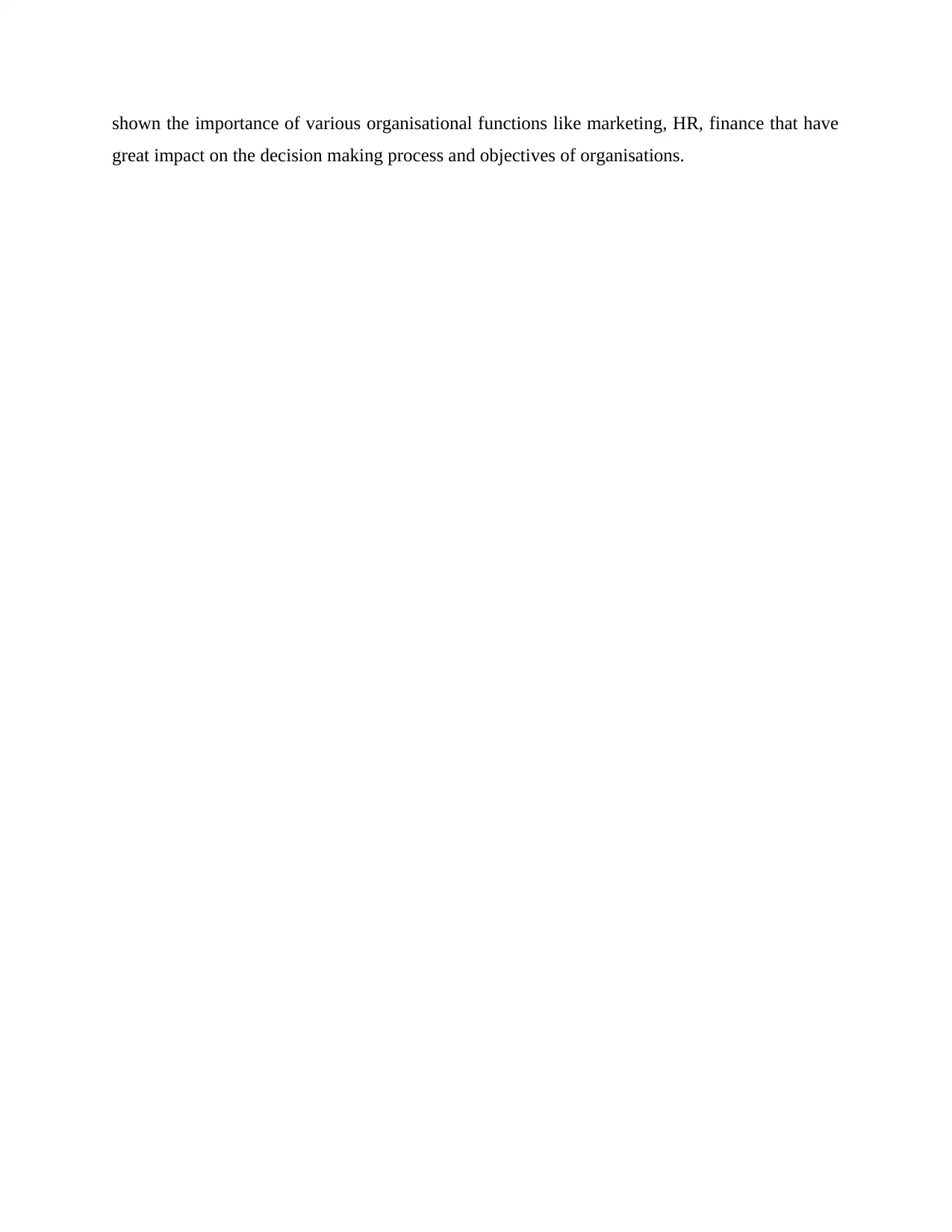
shown the importance of various organisational functions like marketing, HR, finance that have
great impact on the decision making process and objectives of organisations.
great impact on the decision making process and objectives of organisations.
Paraphrase This Document
Need a fresh take? Get an instant paraphrase of this document with our AI Paraphraser
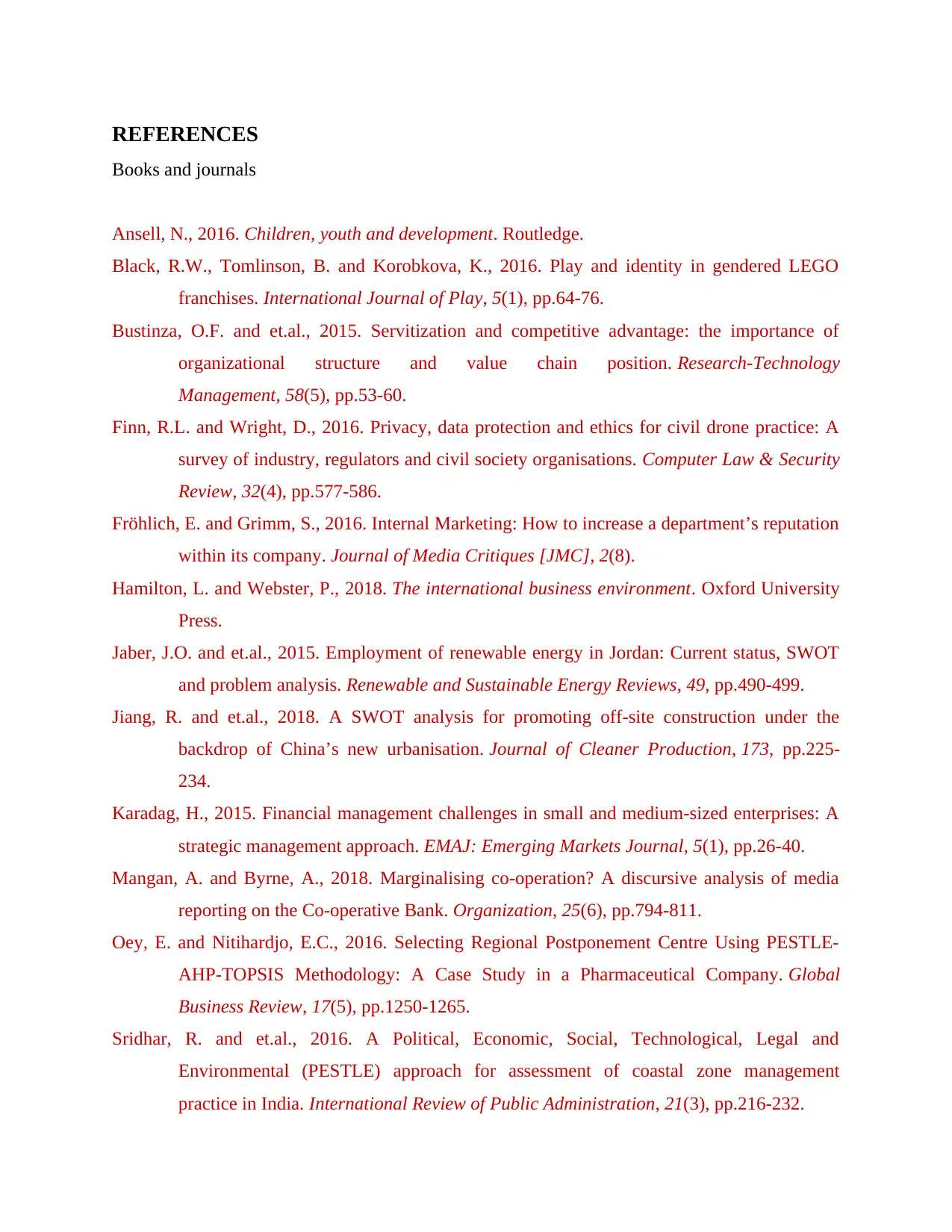
REFERENCES
Books and journals
Ansell, N., 2016. Children, youth and development. Routledge.
Black, R.W., Tomlinson, B. and Korobkova, K., 2016. Play and identity in gendered LEGO
franchises. International Journal of Play, 5(1), pp.64-76.
Bustinza, O.F. and et.al., 2015. Servitization and competitive advantage: the importance of
organizational structure and value chain position. Research-Technology
Management, 58(5), pp.53-60.
Finn, R.L. and Wright, D., 2016. Privacy, data protection and ethics for civil drone practice: A
survey of industry, regulators and civil society organisations. Computer Law & Security
Review, 32(4), pp.577-586.
Fröhlich, E. and Grimm, S., 2016. Internal Marketing: How to increase a department’s reputation
within its company. Journal of Media Critiques [JMC], 2(8).
Hamilton, L. and Webster, P., 2018. The international business environment. Oxford University
Press.
Jaber, J.O. and et.al., 2015. Employment of renewable energy in Jordan: Current status, SWOT
and problem analysis. Renewable and Sustainable Energy Reviews, 49, pp.490-499.
Jiang, R. and et.al., 2018. A SWOT analysis for promoting off-site construction under the
backdrop of China’s new urbanisation. Journal of Cleaner Production, 173, pp.225-
234.
Karadag, H., 2015. Financial management challenges in small and medium-sized enterprises: A
strategic management approach. EMAJ: Emerging Markets Journal, 5(1), pp.26-40.
Mangan, A. and Byrne, A., 2018. Marginalising co-operation? A discursive analysis of media
reporting on the Co-operative Bank. Organization, 25(6), pp.794-811.
Oey, E. and Nitihardjo, E.C., 2016. Selecting Regional Postponement Centre Using PESTLE-
AHP-TOPSIS Methodology: A Case Study in a Pharmaceutical Company. Global
Business Review, 17(5), pp.1250-1265.
Sridhar, R. and et.al., 2016. A Political, Economic, Social, Technological, Legal and
Environmental (PESTLE) approach for assessment of coastal zone management
practice in India. International Review of Public Administration, 21(3), pp.216-232.
Books and journals
Ansell, N., 2016. Children, youth and development. Routledge.
Black, R.W., Tomlinson, B. and Korobkova, K., 2016. Play and identity in gendered LEGO
franchises. International Journal of Play, 5(1), pp.64-76.
Bustinza, O.F. and et.al., 2015. Servitization and competitive advantage: the importance of
organizational structure and value chain position. Research-Technology
Management, 58(5), pp.53-60.
Finn, R.L. and Wright, D., 2016. Privacy, data protection and ethics for civil drone practice: A
survey of industry, regulators and civil society organisations. Computer Law & Security
Review, 32(4), pp.577-586.
Fröhlich, E. and Grimm, S., 2016. Internal Marketing: How to increase a department’s reputation
within its company. Journal of Media Critiques [JMC], 2(8).
Hamilton, L. and Webster, P., 2018. The international business environment. Oxford University
Press.
Jaber, J.O. and et.al., 2015. Employment of renewable energy in Jordan: Current status, SWOT
and problem analysis. Renewable and Sustainable Energy Reviews, 49, pp.490-499.
Jiang, R. and et.al., 2018. A SWOT analysis for promoting off-site construction under the
backdrop of China’s new urbanisation. Journal of Cleaner Production, 173, pp.225-
234.
Karadag, H., 2015. Financial management challenges in small and medium-sized enterprises: A
strategic management approach. EMAJ: Emerging Markets Journal, 5(1), pp.26-40.
Mangan, A. and Byrne, A., 2018. Marginalising co-operation? A discursive analysis of media
reporting on the Co-operative Bank. Organization, 25(6), pp.794-811.
Oey, E. and Nitihardjo, E.C., 2016. Selecting Regional Postponement Centre Using PESTLE-
AHP-TOPSIS Methodology: A Case Study in a Pharmaceutical Company. Global
Business Review, 17(5), pp.1250-1265.
Sridhar, R. and et.al., 2016. A Political, Economic, Social, Technological, Legal and
Environmental (PESTLE) approach for assessment of coastal zone management
practice in India. International Review of Public Administration, 21(3), pp.216-232.

⊘ This is a preview!⊘
Do you want full access?
Subscribe today to unlock all pages.

Trusted by 1+ million students worldwide
1 out of 12
Related Documents
Your All-in-One AI-Powered Toolkit for Academic Success.
+13062052269
info@desklib.com
Available 24*7 on WhatsApp / Email
![[object Object]](/_next/static/media/star-bottom.7253800d.svg)
Unlock your academic potential
Copyright © 2020–2025 A2Z Services. All Rights Reserved. Developed and managed by ZUCOL.





